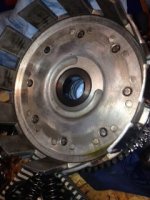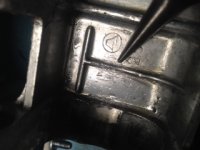A couple of thoughts from someone who has re-ringed a few 350s.
#1, your compression numbers will not be consistent until you break in the new rings. If you have one side at 90psi and the other at 110psi, I wouldn't worry about that for now. Run the bike, it'll smoke a lot, then less, than only a little, then finally not at all. After it doesn't smoke at all, re-check and I bet you're high and consistent on both sides. If you didn't hone / deglaze your cylinders, the rings may not seat and you may always smoke and have bad compression.
#2, that backfiring that you noticed is absolutely the advancer. I have had that happen once (I had no idea why or how it happened) and then a second time (I was much wiser then). Now that its corrected and you're back to an engine that's coughing, you're okay.
#3, your carbs pouring gas into your cylinders will absolutely prevent you from running. I have had this happen before and it can often trick you into thinking you have other issues. If you're pouring gas onto the floor (could be out of the pods), you really should not proceed until you've corrected that. If you didn't set your floats, set them. If you did, add 1 or 2 mm to the setting and try again. This will close the floats sooner, aka less gas in the bowls. If THAT doesn't work, you will need new needles and seats (very cheap IIRC).
Once your carbs are set up, try starting again. I bet it runs and then you'll be able to check your timing. I had a 350 once that ran like shit, and it didn't give a consistent 'blink' on the timing light, more like an intermittant one. It was a bad point. Replaced it and the motor ran beauty. Just something to keep in mind.
Cheers
DS
#1, your compression numbers will not be consistent until you break in the new rings. If you have one side at 90psi and the other at 110psi, I wouldn't worry about that for now. Run the bike, it'll smoke a lot, then less, than only a little, then finally not at all. After it doesn't smoke at all, re-check and I bet you're high and consistent on both sides. If you didn't hone / deglaze your cylinders, the rings may not seat and you may always smoke and have bad compression.
#2, that backfiring that you noticed is absolutely the advancer. I have had that happen once (I had no idea why or how it happened) and then a second time (I was much wiser then). Now that its corrected and you're back to an engine that's coughing, you're okay.
#3, your carbs pouring gas into your cylinders will absolutely prevent you from running. I have had this happen before and it can often trick you into thinking you have other issues. If you're pouring gas onto the floor (could be out of the pods), you really should not proceed until you've corrected that. If you didn't set your floats, set them. If you did, add 1 or 2 mm to the setting and try again. This will close the floats sooner, aka less gas in the bowls. If THAT doesn't work, you will need new needles and seats (very cheap IIRC).
Once your carbs are set up, try starting again. I bet it runs and then you'll be able to check your timing. I had a 350 once that ran like shit, and it didn't give a consistent 'blink' on the timing light, more like an intermittant one. It was a bad point. Replaced it and the motor ran beauty. Just something to keep in mind.
Cheers
DS






